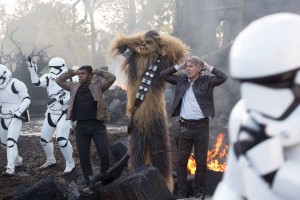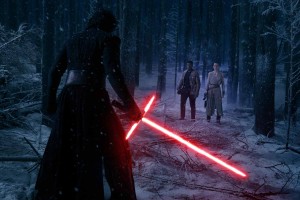
Maintaining Star Wars’ legacy of stellar special effects was important for director J.J. Abrams, tasked with picking up the saga where George Lucas left off when he sold the whole franchise to Disney in 2012. To meet the challenge, Abrams assembled some top-notch VFX department heads for Star Wars: The Force Awakens, including ILM visual effects supervisors Roger Guyett and Pat Tubach, as well as special effects supervisors Neal Scanlan and Chris Corbould – a team that was “destined” to earn an Oscar nomination.
 This is Guyett’s fourth visual effects Oscar nomination. He was previously nominated for Star Trek Into Darkness (2013), Star Trek (2009) and Harry Potter and the Prisoner of Azkaban (2004). This is Tubach’s second nom after Star Trek Into Darkness (2013). This is also Scanlan’s second nomination after taking home an Oscar for his work on Babe in 1995. Corbould took home an Oscar for his work on Inception in 2010, and was also nominated for The Dark Night (2008), making this his third nomination.
This is Guyett’s fourth visual effects Oscar nomination. He was previously nominated for Star Trek Into Darkness (2013), Star Trek (2009) and Harry Potter and the Prisoner of Azkaban (2004). This is Tubach’s second nom after Star Trek Into Darkness (2013). This is also Scanlan’s second nomination after taking home an Oscar for his work on Babe in 1995. Corbould took home an Oscar for his work on Inception in 2010, and was also nominated for The Dark Night (2008), making this his third nomination.
Earlier this month The Star Wars visual effects team won the VES award for outstanding visual effects in a photoreal feature for their work on Episode VII, along with three other awards – outstanding created environment in a photoreal feature, outstanding virtual cinematography in a photoreal project and outstanding models in a photoreal or animated project.
 For Guyett, one of the overriding challenges was “to find our place” in the Star Wars universe. “Obviously we were trying to bring out something with the same DNA as the original movies and with the look of the originals, but still at the same time, not make it a retro movie,” he said.
For Guyett, one of the overriding challenges was “to find our place” in the Star Wars universe. “Obviously we were trying to bring out something with the same DNA as the original movies and with the look of the originals, but still at the same time, not make it a retro movie,” he said.
Guyett explained that there were 2,100 visual effects shots in the film, and the first step was to break them all down and distinguish between “real creatures and in-camera effects, and what we would do in post.”
According to Guyett, the approach to effects was to try “to retain some of the charm of the process of the original movie, with real creatures and real locations, and then mash that up with this incredible new technology that we have in our arsenal, and hopefully by doing that, we’re grounding the work in reality.”
 Tubach added that while the old films gave them a wealth of reference material, there were also a lot of new space ships and new characters that needed to be designed from scratch.
Tubach added that while the old films gave them a wealth of reference material, there were also a lot of new space ships and new characters that needed to be designed from scratch.
“I would say one of the biggest challenges was in the design stage,” said Tubach. “You can do as much artwork as you want. We had a lot of artwork from production designers Rick Carter and Darren Gilford, but once you start getting into production, a lot of those best laid plans need a lot of modification and a lot of love and hard work to make them feel authentically Star Wars.”
“Every single decision that we had to make had to be weighed against the question, ‘Does this feel like something that could exist 30 years on from the original trilogy?’” Tubach added. “We were very careful to be faithful to the original look of the films. That was really an overriding thing hanging over our heads.”
 Guyett explained that an army of over 1,000 VFX artists worked on the project, and “It was a very formidable task breaking it down into the various components and dividing it up between a very large team of people, while collaborating with J.J. and making sure that we’re all heading in the right direction, along with every other department for that matter.”
Guyett explained that an army of over 1,000 VFX artists worked on the project, and “It was a very formidable task breaking it down into the various components and dividing it up between a very large team of people, while collaborating with J.J. and making sure that we’re all heading in the right direction, along with every other department for that matter.”
Guyett and Tubach were already well into post on Star Trek Into Darkness when Abrams took on the project and first approached them. Scanlan also joined the project in the early stages with a team of four concept artists. “In early preproduction we were just exploring ideas for some of the key creatures, Maz being one of them,” said Scanlan.
 Scanlan and his creature effects team were tasked with creating 110 practical creatures for the film. In fact, in one of the most striking scenes in the film, Maz’s Castle, all of the creatures are real, except one – Maz herself. That scene called for a team of 130-140 puppeteers, performers and choreographers. Having real practical creatures allowed Abrams to direct all of actual characters on set.
Scanlan and his creature effects team were tasked with creating 110 practical creatures for the film. In fact, in one of the most striking scenes in the film, Maz’s Castle, all of the creatures are real, except one – Maz herself. That scene called for a team of 130-140 puppeteers, performers and choreographers. Having real practical creatures allowed Abrams to direct all of actual characters on set.
“There was some discussion at the beginning on whether or not Maz could be played more like a practical puppet,” explained Guyett. “J.J. was very inspired by Caesar’s [Andy Serkis’] performance in one of the Planet Of The Apes movies. He wanted Lupita Nyong’o’s performance as Maz to be very nuanced and he wanted to get that kind of quality into that character, so we went in the CG direction.”
“Maz is a fantastic example of this relationship [between practical and visual effects] that we’re talking about, which is so much in the tradition of ILM as a company,” explained Scanlan. “Myself and the concept artists designed Maz. In fact, an artist by the name of Luke Fisher finally came up with the design that J.J. engaged with. At that point we created a full-sized physical maquette – that’s a model that is painted and costumed right and looks exactly like Maz in the film. We then handed that to Roger Guyett and his team and they scanned that and took it forwards.”
Nyong’o’s performance was ultimately captured using facial motion capture techniques.
 But of all of the creatures, the biggest challenge for Scanlan was bringing BB8 to life as a character that had to play consistently throughout the film, and build relationships with all the other key characters in the film.
But of all of the creatures, the biggest challenge for Scanlan was bringing BB8 to life as a character that had to play consistently throughout the film, and build relationships with all the other key characters in the film.
“BB8 was essentially wheeled around and performed by a puppeteer who was dressed in a green or blue suit, and in that way they controlled the body and head of BB8, and then a second person [Dave Chapman] was able to control the rotation, the lights and the lens in BB8’s eye,” explained Scanlan. “The two of them worked together as a team.”
“Brian Herring was doing the body and head of BB8, and if there was a scene with Daisy Ridley, he would act out the part. He would wheel BB8 around, move the head and would even vocalize BB8 sounds so that Daisy could react to this as an actual little character. The two of them created an on-set dynamic and throughout the film they were able to build on that, and after a while Daisy wouldn’t refer to Brian anymore. She would just refer to BB8.”
 For Corbould, one particular challenge was Rey’s speeder. “It was a very unorthodox shape that J.J chose – a great big tractor engine sticking up in the air,” said Corbould. “We had to mechanize that, so we built a full chassis with four wheels, and mounted it on there with a powerful engine that could cross the dessert at 60-70 mph with Rey sitting on the back. It had a hidden driver inside it, so the actor on top could just concentrate on the performance and the guy inside the engine drove it.”
For Corbould, one particular challenge was Rey’s speeder. “It was a very unorthodox shape that J.J chose – a great big tractor engine sticking up in the air,” said Corbould. “We had to mechanize that, so we built a full chassis with four wheels, and mounted it on there with a powerful engine that could cross the dessert at 60-70 mph with Rey sitting on the back. It had a hidden driver inside it, so the actor on top could just concentrate on the performance and the guy inside the engine drove it.”
Corbould explained that the design of the speeder went through an evolution. “We made one version and showed the footage to J.J. and he said, ‘That’s grand. It’s unique. It’s wonderful. Can you make it sway from side to side?’ So we did that and sent the footage back to him again and he said, ‘That’s lovely, but can you make it go up and down one or two feet?’ So every time he saw it he kept improving it.”
For visual effects artists, one of the best compliments is when the audience doesn’t even realize that they’re watching effects. According to Scanlan, “People have asked questions about scenes that they thought were done in CG, but it was really a practical effect. And there are practical effects that people think are done in CG. If we’ve confused them enough, we’ve been successful in giving a uniformity to the project.”





